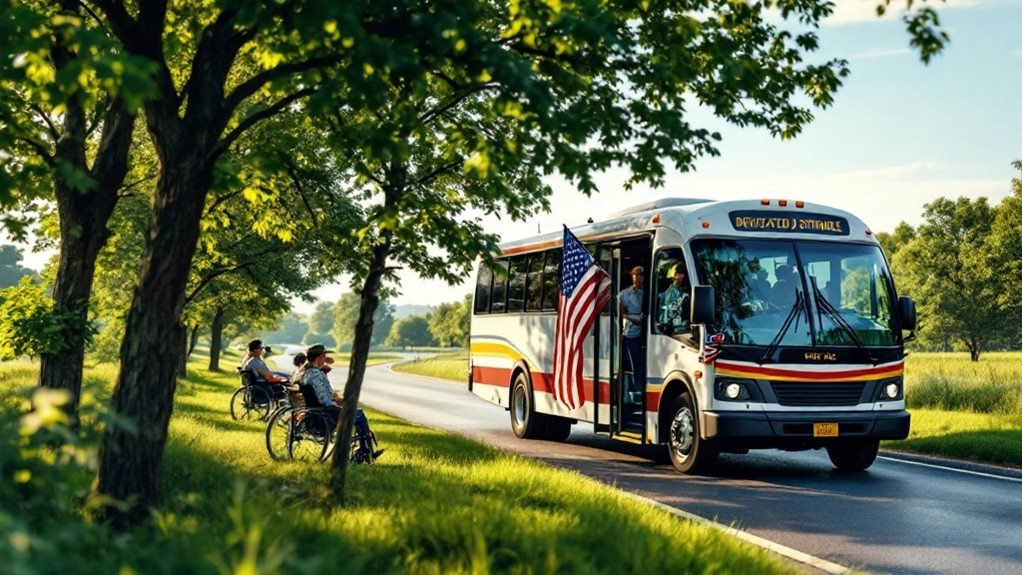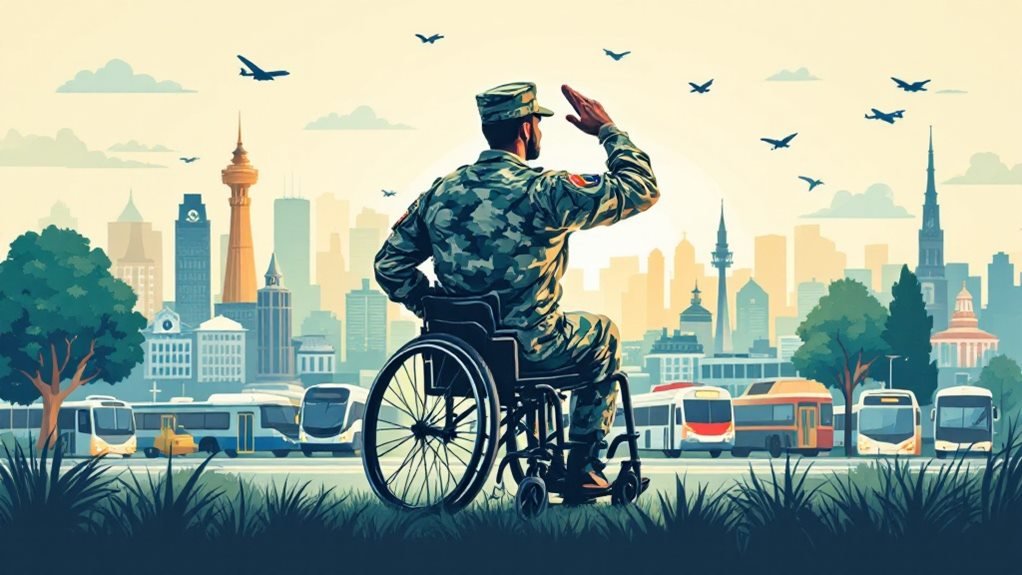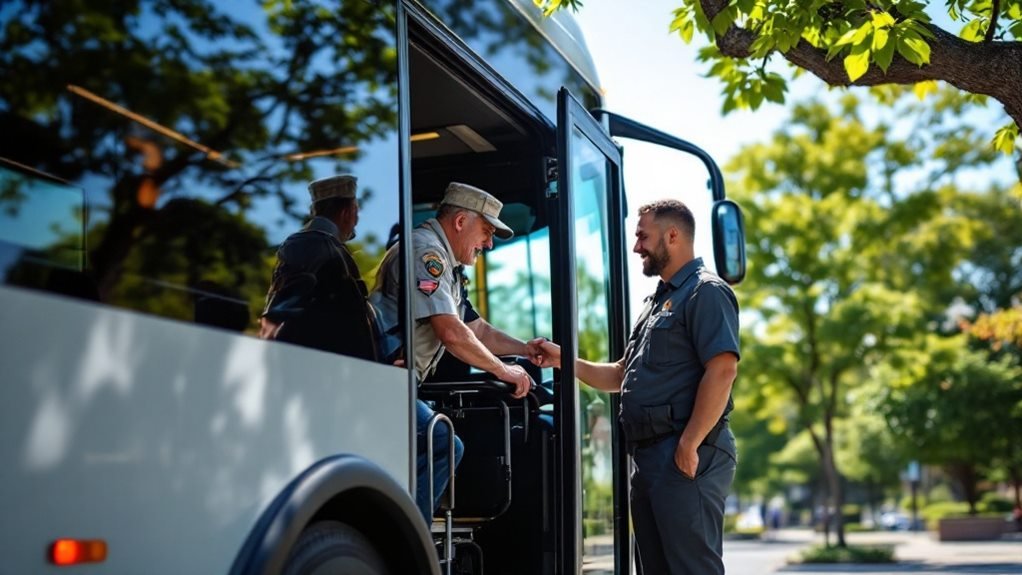Starting a business to transport veterans requires a strategic blend of understanding, compliance, and compassion. We first recognize the unique mobility challenges veterans face, tailoring our services to include wheelchair accessibility and respectful care. Guiding legal requirements means acquiring the right licenses and training staff on safety protocols. Crafting a thorough business plan involves analyzing veteran demographics, forecasting financials, and exploring funding through grants or partnerships. Choosing suitable vehicles guarantees comfort and accessibility remain priorities. Marketing to veteran communities and building trust through face-to-face engagements are essential. As we refine these strategies, the potential to make significant impacts becomes evident.
Key Takeaways
- Research licensing requirements and obtain necessary permits for compliant veteran transportation services.
- Develop a business plan addressing veterans' mobility needs and financial projections.
- Secure funding through grants, partnerships, and crowdfunding for initial capital.
- Acquire accessible vehicles equipped with safety and comfort features for veterans.
- Utilize marketing strategies and community engagement to connect with veteran networks and potential clients.
Understanding Veterans' Transportation Needs
Understanding veterans' transportation needs is essential for anyone looking to enter this specialized field. As we step into this domain, it's vital to recognize the unique veteran mobility challenges that our service members face.
Many veterans live with disabilities or health conditions that require special accommodations. It's not just about getting from point A to point B; it's about ensuring that their journey is safe, comfortable, and respectful of their service.
We must strategically design accessible transport solutions that cater to these needs. This involves understanding the nuances of wheelchair accessibility, reliable scheduling, and personalized service.
Our approach should be rooted in empathy and a genuine desire to enhance their quality of life.
Navigating Legal and Regulatory Requirements
When we explore the domain of transporting veterans, maneuvering through the labyrinth of legal and regulatory requirements is essential. Our mission to serve those who've served demands that we prioritize understanding and adhering to these rules. It's about ensuring not only the safety and dignity of the veterans in our care but also the sustainability of our enterprise.
We begin by thoroughly researching the licensing requirements specific to our state or region, as these can vary greatly. We must obtain the appropriate permits for operating a transportation service, which may include commercial driver's licenses and special vehicle certifications.
Compliance strategies play a pivotal role in our journey. We should develop a robust framework that keeps us informed and aligned with changing regulations. This includes regular training sessions for our team, ensuring everyone is updated on the latest safety protocols and legal obligations.
Developing a Business Plan
As we commence on developing our business plan, let's start by clearly defining our target demographics to guarantee our services meet the specific needs of veterans.
We'll then strategically outline our financial projections, providing a roadmap for sustainable growth and profitability.
Define Target Demographics
Anyone venturing into the business of transporting veterans must strategically define their target demographics to guarantee success. Understanding veteran demographics is our first essential step.
We need to reflect on factors like age, mobility needs, and service-related disabilities. Veterans span a broad age range—from young adults to seniors—each with unique transportation preferences. Some may require specialized vehicles for wheelchairs, while others might prefer more conventional transportation options.
By identifying these specific needs, we can tailor our services to provide the most effective and compassionate solutions.
Let's explore where veterans reside, their frequency of travel, and the common destinations they require transport to, such as medical appointments, social events, or community centers. This insight helps us design routes and schedules that align with their daily lives.
In engaging with this community, we must also contemplate cultural and emotional sensitivities. Many veterans value punctuality, reliability, and a sense of camaraderie.
Offering a service that respects these values not only meets transportation needs but also fosters trust and loyalty. By strategically defining our target demographics, we guarantee our business doesn't just transport veterans, but truly serves them.
Outline Financial Projections
Understanding our target demographics sets the stage for outlining our financial projections, an integral part of developing a robust business plan. With a clear picture of who we aim to serve, we can strategically approach our cost analysis and revenue forecasting.
Our mission to transport veterans demands a deep understanding of both fixed and variable costs. We must consider vehicle acquisition, maintenance, fuel, insurance, and staffing as key components of our financial structure. By identifying these elements, we can accurately estimate our initial and ongoing expenses.
Now, let's turn our attention to revenue forecasting. It's crucial to project income streams by analyzing potential service contracts, government subsidies, and individual service fees. We should also explore partnerships with veteran organizations, which might provide additional funding or referrals.
By aligning our revenue projections with our service goals, we guarantee financial sustainability while fulfilling our mission to serve those who served us.
As we refine our financial projections, let's remain flexible and ready to adapt to changes in the market or funding opportunities. By combining strategic cost analysis with realistic revenue forecasting, we can craft a business plan that supports our vision and enhances our ability to serve veterans effectively.
Securing Funding and Resources
Securing funding and resources is a critical step in launching a successful venture to transport veterans. To make a meaningful impact, we must strategically explore various avenues.
First, we should consider grant opportunities. Many government and private organizations offer grants specifically designed to support initiatives that benefit veterans. By identifying and applying for these grants, we can secure substantial funding without needing to repay it, allowing us to focus on building our services.
Additionally, crowdfunding strategies can play a significant role in mobilizing community support. Platforms like Kickstarter or GoFundMe enable us to tap into a network of individuals who are passionate about assisting veterans. By crafting a compelling story and clearly articulating the mission, we can inspire people to contribute to our cause.
Remember, transparency and regular updates foster trust and encourage continued support.
It's also beneficial to network with local businesses and veteran organizations. Partnerships can lead to shared resources or even sponsorships, providing additional support.
Acquiring Suitable Vehicles
To effectively transport veterans, we must strategically focus on acquiring suitable vehicles tailored to their needs. Understanding the diverse requirements of veterans is vital. We need to contemplate vehicle types that offer flexibility and comfort.
Whether it's a passenger van, a minivan, or a bus, the choice should reflect the specific demands of our clientele. It's important to evaluate the capacity, efficiency, and reliability of each option.
Accessibility features are non-negotiable. We must guarantee that our vehicles are equipped with ramps, lifts, and adequate space for wheelchairs. This will enhance the ease of entry and exit for veterans with mobility challenges.
Prioritizing features such as adjustable seating, handrails, and slip-resistant flooring will greatly contribute to their comfort and safety.
Additionally, it's wise to think about vehicles that are adaptable to future technological advancements. Staying informed about the latest innovations can help us make decisions that keep our fleet modern and efficient.
Marketing Your Transport Services
Having equipped ourselves with the right vehicles to serve our veterans, the next step is to effectively communicate our offerings through strategic marketing. Our mission to provide reliable transportation needs to reach the very communities we aim to support.
We must harness the power of social media, as it's a crucial tool in today's digital landscape. By creating engaging content, sharing testimonials, and highlighting our services, we can capture the attention of both veterans and their families.
In addition to our online efforts, community outreach remains paramount. We should engage with local veteran organizations and participate in community events.
Face-to-face interactions build trust and establish our presence as a dedicated service provider. Let's host informational sessions where we can directly address concerns and showcase how our services can enhance veterans' quality of life.
Building Partnerships and Community Connections
To effectively serve our veterans, we need to strategically connect with local organizations and veteran support networks.
By collaborating with these groups, we can create a robust network that enhances our reach and impact.
Let's focus on partnerships that not only expand our business but also strengthen our commitment to those who've served.
Collaborate With Local Organizations
Establishing strong partnerships with local organizations can greatly enhance our efforts in transporting veterans effectively. By engaging in community outreach, we can identify key players who share our commitment to serving veterans. Local non-profits, veteran service organizations, and municipal agencies often have resources that align with our mission.
Building these relationships allows us to pool resources, share information, and create a more robust network of support. When we strategically collaborate, resource sharing becomes a powerful tool. Local organizations might've access to facilities, volunteers, or funding opportunities that we can synergize with our transportation capabilities.
This collaboration not only reduces costs but also amplifies our impact. Together, we can organize community events to raise awareness and gather additional support from residents and businesses who are enthusiastic to contribute to this noble cause.
Moreover, by fostering these connections, we're able to stay informed about the specific needs of veterans in our area. This insight enables us to tailor our services more effectively, ensuring that we're addressing the most pressing transportation challenges.
Let's remember that our primary goal is to make a meaningful difference in the lives of veterans, and collaboration is key to achieving that.
Engage Veteran Support Networks
Engaging veteran support networks is a strategic move that can greatly expand our reach and effectiveness in providing transportation services to veterans. By tapping into these established networks, we can connect with a community already dedicated to veteran outreach and support programs. This collaboration allows us to identify transportation needs more accurately and guarantee we're addressing them efficiently.
To begin, we should identify and reach out to organizations already involved in veteran support. These could include local veteran service organizations, non-profits, and governmental agencies. By building partnerships with these groups, we not only leverage their expertise but also gain credibility within the veteran community. This trust is essential as we aim to serve a group that's often underserved.
Furthermore, engaging with these networks opens doors to potential funding opportunities and grants specifically designed for veteran support programs. By aligning our goals with these organizations, we can create a more sustainable model for our transportation services.
Let's remember, our primary aim is to serve, and by integrating with existing support networks, we're amplifying our impact. Together, we can guarantee that our veterans have reliable access to the transportation services they deserve.
Conclusion
In our journey to support veterans through transportation services, we've uncovered that over 3.5 million veterans face transportation challenges each year. By understanding their unique needs, maneuvering through regulations, and building strategic partnerships, we can make a tangible difference. Let's leverage our resources and expertise to create a reliable, veteran-focused service. Together, we can bridge the gap and guarantee veterans get where they need to be, honoring their service with our commitment and care.



